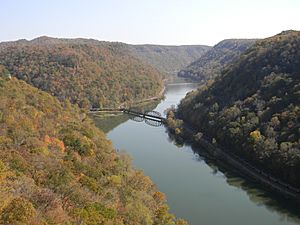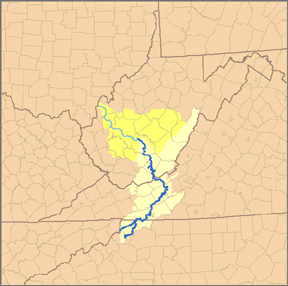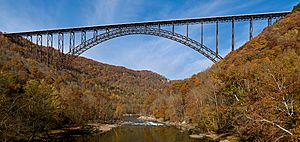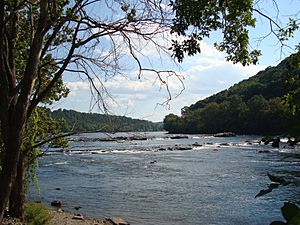New River (Kanawha River tributary) facts for kids
Quick facts for kids New River |
|
|---|---|

The New River within the New River Gorge as viewed from Hawks Nest State Park in West Virginia
|
|

Map of the Kanawha River watershed, with the New River (dark blue) and its watershed (light yellow) highlighted.
|
|
| Country | United States |
| State | North Carolina, Virginia, West Virginia |
| Counties | Ashe NC, Alleghany NC, Watauga NC, Grayson VA, Carroll VA, Wythe VA, Pulaski VA, Montgomery VA, Giles VA, Mercer County, West Virginia, Summers County, West Virginia, Raleigh County, West Virginia, Fayette County, West Virginia |
| Physical characteristics | |
| Main source | South Fork New River Boone, NC 3,104 ft (946 m) 36°12′16″N 81°38′59″W / 36.20444°N 81.64972°W |
| 2nd source | North Fork New River Elk Knob, Watauga County, NC 4,446 ft (1,355 m) 36°19′59″N 81°41′04″W / 36.33306°N 81.68444°W |
| River mouth | Kanawha River Gauley Bridge, West Virginia 653 ft (199 m) 38°09′42″N 81°11′47″W / 38.16167°N 81.19639°W |
| Length | 320 mi (510 km) |
| Basin features | |
| Tributaries |
|
| Type: | Scenic |
| Designated: | April 13, 1976 |
The New River is a long river that flows through North Carolina, Virginia, and West Virginia. It eventually joins the Gauley River to form the Kanawha River. This happens near the town of Gauley Bridge, West Virginia. The New River is part of the larger Ohio River system. It stretches for about 360 miles (580 km).
It's called the "New River," but it's actually one of the oldest rivers in the world! Scientists believe it's millions of years old. This ancient river has created a special path through the Appalachian Mountains. This path has allowed many different plants and animals to spread across the eastern and midwestern United States.
The New River Gorge is a very beautiful place. It's also popular for exciting activities like white-water rafting and kayaking. Many spots along the gorge offer amazing views. Two popular places are Hawks Nest State Park and overlooks in the New River Gorge National Park and Preserve. The New River Gorge and its famous bridge are even shown on the West Virginia State Quarter, which was made in 2005.
Contents
Where the New River Flows
This very old river starts in the Blue Ridge Mountains of North Carolina. It begins near the city of Boone, North Carolina. The river then flows generally northeast through different mountain ranges in North Carolina and Virginia. After that, it turns and flows northwest into West Virginia.
In West Virginia, the river cuts through the Appalachian Plateau. This part is known as the New River Gorge. Finally, it meets the Gauley River and becomes the Kanawha River. The Kanawha River then flows into the Ohio River. Much of the New River's path has steep cliffs and rocky areas. These are especially noticeable in its gorge in West Virginia.
The New River is formed when two smaller rivers meet. These are the South Fork New River and the North Fork New River. They join together in Ashe County, North Carolina. The river then flows through southwestern Virginia. It passes near Galax, Virginia. Along this part, it is held back by three small dams. These are at Fries, Byllesby Dam, and Buck Dam.
Further north, the river enters Pulaski County, Virginia. Here, it is held back by Claytor Dam, forming Claytor Lake. North of the dam, the New River is joined by the Little River. It then flows past the city of Radford, Virginia. The river continues north through Giles County, Virginia and the town of Narrows. After this, it crosses into West Virginia.
Dams and Bridges Along the River
The New River is held back by Bluestone Dam in Summers County, West Virginia. This creates Bluestone Lake. The Bluestone River also flows into the New River in Bluestone Lake. Just below the dam, the Greenbrier River joins the New River. The New River then continues its journey into the New River Gorge.
Near the end of the gorge, the river flows past the town of Fayetteville, West Virginia. A few miles northwest of Fayetteville, much of the New River's water is sent through the 3-mile (4.8 km) Hawks Nest Tunnel. This water is used to create electricity. The water then flows back into the river just before Gauley Bridge. Here, the New River combines with the Gauley River to form the Kanawha River. The Kanawha River is a branch of the Ohio River, which then flows into the Mississippi River.
Not many roads cross the deep gorge. The most amazing bridge is the New River Gorge Bridge on U.S. 19. It is a steel arch bridge that spans 1,700 feet (518 m). The road is 876 feet (267 m) above the river. This bridge is the third-longest single-arch bridge in the world. It is also one of the world's highest vehicular bridges. When it was built, it was the highest bridge carrying a regular road.
The River's Ancient Story: Geology
Even though it's called "New River," many geologists believe it's one of the oldest rivers in the world. It's definitely one of the oldest in North America. The New River flows from south to north. This is unusual because most other major rivers in the eastern U.S. flow from west to east. The New River cuts right through the Appalachian Mountains.
Scientists think the New River has been flowing in its current path for at least 65 million years. In the past, the New River was much longer. Geologists call this ancient, longer river the Teays. A long time ago, huge sheets of ice covered much of this river. The ice caused the New River's water to flow into other rivers. These rivers became the Ohio and Kanawha Rivers we know today.
Amazing Nature: Plants and Animals
As the New River travels through the New River Gorge, it passes through many different rock formations. The rocks, cliffs, and even old coal mines create many different places for plants and animals to live. In the gorge, the difference in height between the river bottom and the top of the plateau is often 1000 feet. The New River cuts through all the main parts of the Appalachian Mountains. Because of this, it acts like a pathway. It helps southern plant and animal species move into West Virginia. The gorge also acts as a barrier. It stops some species from spreading from east to west.
Because the New River is so old, its habitats and wildlife have become very stable. Millions of years of open passage have allowed many species to move in and stay in the area. Since the New River cuts through the Appalachians from east to west, you can find plants that usually live on the Atlantic coast. These grow alongside plants that are common in northern mountains. Over time, some unique species have developed here. Several types of fish have evolved that are endemic to this river. This means they are found nowhere else in the world.
Plants of the Gorge
The New River Gorge is at the center of one of the largest untouched forests in the world. The gorge section of the New River has more different kinds of plants than any other river gorge in the central and southern Appalachians. This is partly because there are very wet and very dry areas between the river and the rim of the gorge. This part of West Virginia is known for its Mixed Mesophytic Forest Region. You can find different types of forests here. These include oak-hickory, mixed oak, and hemlock-hardwood forests.
The gorge also has a rare plant community called the Appalachian Flatrock. This community includes sedges, cedars, and pines. These plants grow on flat sandstone ledges along the New River. They need occasional floods to keep their habitat healthy.
Animals of the Gorge
Many different animals live in and around the New River, its gorge, and the surrounding forests. The New River has long been a path for animals to move. Because of this, animals usually found much farther south can reach the northern edge of their range here. Likewise, animals from northern forests can reach the southern edge of their range in this area. Some animals are found only in the New River area. These are called endemic species. They were separated from similar groups by the steep terrain or the river's rapids. Because they were isolated, these animals changed over time to fit the unique conditions of the New River Gorge.
About 65 types of mammals live in the New River Gorge area. These include beavers, mink, muskrats, and river otters. The continuous forest, old mine entrances, and streams provide homes for many amphibians. Large aquatic salamanders called hellbenders live here. There are nearly 40 types of reptiles. These include eastern fence lizards, five-lined skinks, copperhead snakes, and snapping turtles. Many tiny creatures also live in the river. These are called Benthic Macroinvertebrates. They include worms, crustaceans, and young aquatic insects like dragonflies and mayfly nymphs.
The New River and its gorge are important homes for birds. You can see bald eagles, osprey, great blue herons, and kingfishers. Many ducks and migrating water birds also visit. These include loons, cormorants, and hooded mergansers. Other migrating birds, like the Cerulean warbler, also rely on this area.
Fish of the River
The New River basin is home to seven types of fish found nowhere else. These are the: Appalachia darter, bigmouth chub, bluestone sculpin, candy darter, Kanawha darter, Kanawha minnow, and New River shiner.
History of the New River
The first recorded trip to explore the river was in 1671. It was led by Batts and Fallam. They were on a fur trading trip for Colonel Abraham Wood. Because of Wood, the New River was sometimes called "Wood River" or "Wood's River." Mary Draper Ingles traveled through the gorge in 1755. She was escaping after being captured by the Shawnees. If you hike or drive through the New River Gorge today, you can still see old stone walls and building foundations. You might also spot old coal mine entrances and coke ovens decaying next to the railroad tracks.
The New River and its gorge have been turned into protected parks and recreation areas. In 1978, the U.S. Congress named the New River Gorge the "New River Gorge National River." This decision came after many discussions. People wanted to protect the area. The main goal at first was to stop a dam project in Virginia and North Carolina. This dam would have affected the water flow and quality in the gorge. People in West Virginia joined others to stop the dam. Then, they worked to protect the New River in West Virginia.
Fun Activities: Recreation
The New River Gorge Bridge near Fayetteville, West Virginia, crosses the New River. Once a year, on Bridge Day, people can even do BASE jumping from it! The river is also very popular for white water rafting. Many companies offer guided trips. The water is colder in spring, but the rapids are more challenging then. Near the bridge, there are also over 1400 places for sport climbing. There are also trails perfect for hiking and mountain biking.
Parks, Forests, and Trails
Here are some of the parks, forests, and trails along the New River, listed from upstream to downstream:
- Pisgah National Forest (on the South Fork)
- Elk Knob State Park (on the North Fork)
- New River State Park, North Carolina
- New River Trail State Park, Virginia
- Shot Tower Historical State Park, Virginia
- Claytor Lake State Park, Virginia
- Jefferson National Forest
- Appalachian National Scenic Trail
- Bluestone Wildlife Management Area
- Bluestone State Park, West Virginia
- New River Gorge National Park and Preserve
- Babcock State Park, West Virginia
- Hawks Nest State Park, West Virginia
Protecting the River and Its Future
Much of the New River's path through West Virginia is part of the New River Gorge National Park and Preserve. The New River is also one of the nation's American Heritage Rivers. In 1975, North Carolina named a 26.5-mile (42.6 km) section of the river a "New River State Scenic River." This part was added to the National Wild and Scenic Rivers System the next year.
Scientists have studied the water quality of the New River. Their findings show that some parts of the river have pollution. This can come from old mining areas or from runoff in towns. Other sources of pollution include old landfills and illegal dumping. Runoff from farms and roads can also add to the problem. Sometimes, waste from homes or recreation areas can get into the water.
Many of the original forests in the gorge have been changed over time. This is due to logging, mining, farming, and building roads. New construction and more visitors also put pressure on the natural areas. Power lines and their paths also cause issues. These areas are often treated with chemicals or cut down.
The park is also in the path of the gypsy moth spread. These moths can harm trees. Scientists need more information to manage this problem. Many areas in the New River Gorge have been affected by past mining for coal, oil, and gas. The park has found 115 abandoned mine sites. Many of these were left before 1977 and have not been fully cleaned up. Since 1987, the National Park Service has worked to fix the most dangerous of these sites.
Air pollution in the park comes from dust from construction and smoke from burning wood. Car exhaust and forest fires also add to it. A big problem for the park is dealing with trash. Hundreds of illegal dumps and trash along roads create problems for nature and safety. There is also a risk of spills from active train lines and old mines.
Over time, the New River Gorge has been a safe place for plants and animals. It has helped them survive as their homes changed with the weather. As global climate patterns continue to shift, the New River Gorge will be an important home for species that need to move from warmer areas.
Other Names for the New River
The New River has been known by several other names throughout history:
- Conhaway River
- Great Konhaway River
- Kanawha River
- Kunhaway River
- Mon-don-ga-cha-te
- Wood River
- Wood's River
- Woods River
Images for kids
-
The New River in the New River Gorge.





